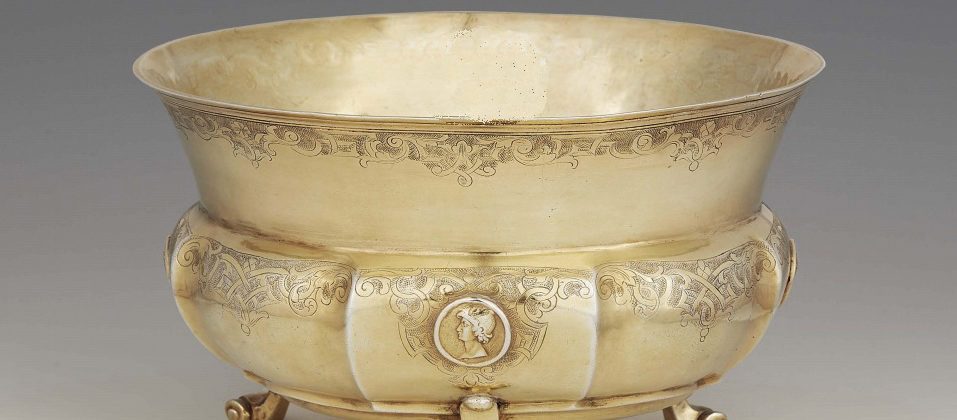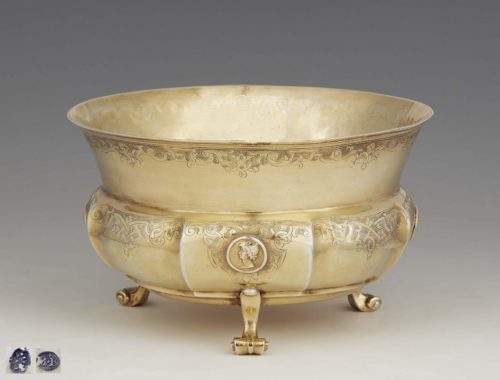Object number : 371
Augsburg around 1700-1707
Matthew III Baur
City hallmark: “Pyr” for Augsburg R1 No. 209 (1700-1707)
Maker’s mark: “M B” for Matthäus III Baur, (born around 1693, died 1758) becomes a master craftsman in 1724, (R3 No. 723, Seling No. 2160)
Height: 10 cm (3.94 in.); Diameter: 16.5 cm (6.5 in.); Weight: 339 g
Detailed Description
The very finely engraved, silver-gilt Régence bowl captivates at first glance with its elegant shape: its spherical body, constricted in the middle, rises above three rolled, graceful volute feet. These are attached to the profiled bottom of the bowl and give the bowl a playful lightness. The lower half of the shell is divided into eight vertical stripes, four of which are more pronounced. These are decorated in the center with antique, round portrait medallions. Above the central constriction, the bowl continues round and tapers towards the top in a narrow, elegantly curved edge.
Below the upper edge of the bowl there is a narrow, graceful-looking banded frieze, consisting of stylized rolled acanthus leaves, volutes, stylized flowers and geometrically arranged bands, which is emphasized by the darker background engraved and punched in fine lines. Also below the constriction of the vessel was a symmetrically arranged band frieze divided into eight sections, which repeated in every other horizontal field, protrudes downwards in a triangle and surrounds the vessel like a border. It consists of the same bandwork elements as the narrower frieze on the edge of the bowl, but is laid out much wider and forms a delicate frame for the four round, three-dimensional portrait medallions attached to it. The original fire gilding of the bowl is still preserved on the whole vessel, the bowl impresses with its fine engraving and its elegant shape and good quality.
The goldsmith Matthäus III Baur, like his contemporary Gottlieb Menzel, probably used the same template sheets by Johann Erhard Heiglen / Heuglin (1687–1757) for his silver-gilt large box on four volute feet # 362, which were made by Johann Jacob Baumgartner between 1721 and 1727 were issued. Some of these sheets are now in the MAK, the Austrian Museum of Applied Arts in Vienna. This treasure trove also served as a model for a “Rosewater Ewer by Johann Erhard Heiglen around 1730” in the Metropolitan Museum of Art in New York and a “Beaker and Cover by Johann Erhard Heuglin II, around 1722-1726” in the Victoria & Albert Museum in London .
Maker:
Matthäus III Baur was one of the leading goldsmiths in Augsburg in the first half of the 18th century, with whom he worked on large orders. He was born around 1693, received the title of master craftsman in 1724 and died in 1758. Numerous coffee pots are known from Matthäus III Baur, but also bowls and kummen from a gilded travel service that is now in the Bavarian National Museum in Munich. Matthäus III Baur also made parts for the well-known Hildesheim dinner service, for which he created a coffee and a milk jug, among other things.
Literature
Rosenberg, Marc, The goldsmith’s mark R3, Volume I, Germany A-C, Frankfurt a. Main 1922, p. 31, no. 209, p. 157, no. 723
Seling, Helmut, Die Augsburger Gold- und Silberschmiede 1529-1868, Meister, Marken, Werke, Munich 2007, p. 47, no. 1430, p. 534, no. 2160



